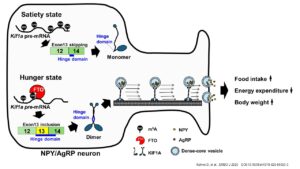Daisuke Kohno 1, Reika Kawabata-Iwakawa 2, Sotaro Ichinose 3, Shigetomo Suyama 4 5, Kazuto Ohashi 6, Winda Ariyani 7, Tetsushi Sadakata 8, Hiromi Yokota-Hashimoto 7, Ryosuke Kobayashi 9, Takuro Horii 9, Vina Yanti Susanti 7 10, Ayumu Konno 11 12, Haruka Tsuneoka 7, Chiharu Yoshikawa 7, Sho Matsui 13, Akihiro Harada 14, Toshihiko Yada 5 15 16 17, Izuho Hatada 9 12, Hirokazu Hirai 11 12, Masahiko Nishiyama 18, Tsutomu Sasaki 13, Tadahiro Kitamura 7 (1Metabolic Signal Research Center, Institute for Molecular and Cellular Regulation, Gunma University, 2Division of Integrated Oncology Research, Gunma University Initiative for Advanced Research (GIAR), 3Department of Anatomy, Gunma University Graduate School of Medicine, 4Department of Physiology, Keio University School of Medicine, 5Division of Integrative Physiology, Department of Physiology, Jichi Medical University School of Medicine, 6Institute for Molecular and Cellular Regulation, Gunma University, 7Metabolic Signal Research Center, Institute for Molecular and Cellular Regulation, Gunma University, 8Education and Research Support Center, Gunma University Graduate School of Medicine, 9Laboratory of Genome Science, Biosignal Genome Resource Center, Institute for Molecular and Cellular Regulation, Gunma University, 10Internal Medicine Department, Faculty of Medicine, Gadjah Mada University, 11Department of Neurophysiology & Neural Repair, Gunma University Graduate School of Medicine, 12Viral Vector Core, Gunma University, Initiative for Advanced Research (GIAR), 13Division of Food Science and Biotechnology, Graduate School of Agriculture, Kyoto University, 14Department of Cell Biology, Graduate School of Medicine, Osaka University, 15Division of Integrative Physiology, Center for Integrative Physiology, Kansai Electric Power Medical Research Institute, 16Department of Diabetes, Endocrinology and Metabolism/Rheumatology and Clinical Immunology, Gifu University Graduate School of Medicine, 17Center for One Medicine Innovative Translational Research, Gifu University Institute for Advanced Study, 18Gunma University, Maebashi, Japan.)
About
N6-methyladenosine (m6A) is an abundant chemical RNA modification involved in the regulation of many biological processes. The m6A demethylase FTO (fat mass and obesity-associated protein) is known to affect body weight, but its systemic context and underlying mechanisms remain unclear. Here, we found that mice lacking or overexpressing Fto in agouti-related peptide-expressing (AgRP) neurons in the hypothalamus exhibited decreased and increased body weight, respectively. FTO demethylated m6A on mRNAs for proteins associated with membrane trafficking and alternative splicing in AgRP neurons. Downstream, FTO-modulated alternative splicing of the axonal motor protein Kif1a affected its hinge region, which is relevant to the structure and function of KIF1A. Notably, Kif1a knockdown in AgRP neurons suppressed the weight gain of mice overexpressing Fto. In addition, FTO increased the trafficking and secretion of dense-core vesicles containing neuropeptides NPY and AgRP from AgRP neurons. Collectively, these results reveal a novel regulatory FTO-KIF1A axis in the brain affecting appetite-stimulating AgRP neurons and systemic energy homeostasis, via FTO regulation of the epitranscriptome of AgRP neurons.
Paper information
Kohno D, Kawabata-Iwakawa R, Ichinose S, Suyama S, Ohashi K, Ariyani W, Sadakata T, Yokota-Hashimoto H, Kobayashi R, Horii T, Susanti VY, Konno A, Tsuneoka H, Yoshikawa C, Matsui S, Harada A, Yada T, Hatada I, Hirai H, Nishiyama M, Sasaki T, Kitamura T. FTO promotes weight gain via altering Kif1a splicing and axonal vesicle trafficking in AgRP neurons. EMBO J. 2025 Jul 9
Online URL
https://doi.org/10.1038/s44318-025-00503-3








